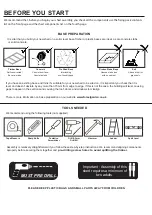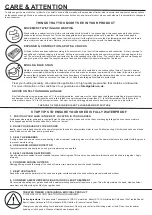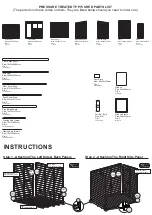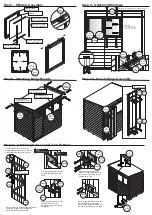
CARE & ATTENTION
MOVEMENT, TWISTING AND WARPING
Wood contains a natural level of moisture so decreasing humidity levels in the surrounding air may cause panels to change their
shape as the porous fibres shrink.
This can be exaggerated during prolonged periods of dry weather. Movement and gaps in
timber products are normal. In most cases, the wood will revert to its original form once the high temperatures subside and there is
more moisture content in the air. Similarly, in winter months, the opposite may occur with the wood swelling.
EXPANSION, CONTRACTION, SPLITS & CRACKS
All timber will expand and contract according to its environment. As a result of this expansion and contraction, it is very common to
see splits and cracks developing in the wood. Splits are common during the spring and summer months as the wood begins to dry
out.
The outer surface dries first and contracts over the still expanded core of the wood.
The result is that splits and cracks appear
along the grain of the wood.
These splits are not a fault and do not affect the structural integrity of a product.
To help you get the most out of our products, it is useful to know a little more about the properties of timber , what is normal and how your shed may behave
as the seasons change. Wood is an extremely durable material for construction but, as a natural product, when used outdoors it is susceptible to changes in
the environment.
THINGS THAT YOU MIGHT SEE IN YOUR PRODUCT
MOULD & BLUE STAIN
Mould is a surface-dwelling fungus that feeds on nutrients and debris contained in the surface cells of timber. The most common
problems associated with mould are discolouration of the timber and an increase in permeability of the timber. Blue stain is part of
the same family but penetrates deeper into the surface layers of the timber. It stains the timber a dark blue colour, whereas mould
is usually black. These do not cause the timber to rot. Keep the building well ventilated to avoid mould.
Treat your building annually. We advise the application of a high quality preservative that contains a mildewcide.
For more information on the conditions of our guarantee see
forestgarden.co.uk.
ADVICE ON FELT HANDLING & USAGE
Roof felt is flexible at temperatures above 5°C. In cold temperatures, extra care must be taken when handling and installing to prevent cracking
and damage to the felt.
The felt should not be rolled, folded or used in temperatures lower than 5°C. In cold temperatures, the felt should be
stored indoors above 10°C for 24 hours prior to use. Felt must be lifted, not dragged, and should be stored on its end on a dry surface.
THE ROOF OF THIS BUILDING IS NOT A LOAD BEARING STRUCTURE
8 TOP TIPS TO ENSURE YOUR SHED IS FULLY WATERPROOF
1. POSITION YOUR SHED IN THE BEST LOCATION IN YOUR GARDEN
Avoid areas where water pools and is constantly wet. Position away from trees and cut back any overhanging foliage which can cause moisture
to be trapped against shed walls and debris to collect on the roof.
2. RAISE YOUR SHED OFF THE GROUND
Ideally, any concrete base should be the same footprint as the shed to allow surface water to run off without pooling. A timber shed base can also be
used. Raise your shed 50mm above ground level.
3. SEAL THE BEARERS
If using a wooden base, we recommend treating it with a treatment containing wax or oil. Also coat the bearers that come into contact with the ground
4. USE AN END-GRAIN PROTECTOR
To protect corners and panel joins, an end grain treatment can be applied.
5. SEAL THE PANELS & WINDOWS
Use a flexible silicon sealant around windows to prevent water ingress.
This can also be used where two sections of the shed join together . Apply
internally.
6. CONSIDER ADDING GUTTERS
Adding guttering around the fascia of the shed will redirect rain water away from the shed's foundation.
7. KEEP VENTILATED
Good airflow around the perimeter of the shed and regular ventilation inside the shed will help prevent mould and mildew
.
8. CONSIDER A WEATHERPROOFING STAIN OR CLEAR TREATMENT
W
e recommend painting your garden shed with a weatherproofing treatment at least once a year.
This will help maintain the wood, stabilise timber
movement and help prolong the life of your garden shed.
TREATED TIMBER CONTAINING A BIOCIDAL PRODUCT
CONTROL OF WOOD DESTROYING ORGANISMS
Active Ingredients
- Propiconazole, Tebuconazole, IPBC, Permethrine, Benzyl-C12-16-Alkyldimethyl Chlorides. (Dip Treated Sheds)
Basic Copper Carbonate, DDA Carbonate, DDA Chloride. (Pressure Treated Sheds)
Wear gloves when handling. Avoid inhalation of sawdust. Do not get in contact with drinking water or food. Do not use for animal
bedding or in fish ponds. Dispose of treated wood responsibly
.
to prevent moisture rising.
























